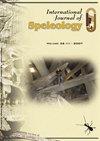Preliminary data of potentially hazardous radon concentrations in Modrič Cave (Croatia)
IF 1.3
4区 地球科学
Q3 GEOSCIENCES, MULTIDISCIPLINARY
引用次数: 0
Abstract
Instigated by relatively high cave-air CO2 concentrations in Modrič Cave (Croatia) recorded for the purpose of speleothem-based paleoclimate research, we established preliminary monitoring of radon (222Rn) concentrations within the cave for a 4.5-year period (2018–2022). As radioactive geogenic gas, radon, which often correlates with cave-air CO2 concentrations, presents a potential health hazard in cases of longer exposure time in high concentration conditions. Since the Modrič Cave is open to tourists and long-term scientific research has been performed within, a safety assessment for radon concentrations was essential. The integrated measurements of radon concentrations were performed by passive LR115 detectors that were exposed from three to six months at eight sites within the cave. Preliminary results showed seasonal variations of radon concentrations (0.08–13.6 kBq/m3) governed by the cave ventilation patterns, but superimposed on this, cave morphology and bedrock architecture control the radon variations on finer spatial scale. The 3-months average 222Rn concentration of up to 13.6 kBq/m3 during summer in one of the cave passages is among the highest measured seasonal averaged radon concentrations in Croatian caves, but maximum concentrations were even higher. Based on obtained results and calculations, potential negative health effects of radon exposure for cave visitors, guides and scientists were assessed and the results showed values of exposure to be below recommended levels. Calculated worst-case scenario for cave guides (most affected by radon and its progeny) revealed that they would receive dose slightly below the occupational dose limit of 20 mSv/y (19.0 ± 5.2 mSv/y) in the touristic part of the cave and significantly higher doses (34.1 ± 9.2 mSv/y) in the non-touristic part of the cave. To detect precise spatio-temporal radon concentration variations (up to diurnal scale) we recently established continuous radon measurements. This will enable detection of possibly health threatening short-term peaks in radon concentration and consequently further improve cave management.Modrič洞穴潜在危险氡浓度的初步数据(克罗地亚)
为了进行基于洞穴的古气候研究,我们在克罗地亚莫德里尼奥奇洞穴中记录了相对较高的洞穴空气二氧化碳浓度,为此,我们对洞穴内的氡(222Rn)浓度进行了为期4.5年(2018-2022)的初步监测。氡作为放射性地源气体,通常与洞穴空气中的二氧化碳浓度相关,在高浓度条件下长时间暴露会对健康造成潜在危害。由于莫德里涅奇洞穴向游客开放,并在洞穴内进行了长期科学研究,因此必须对氡浓度进行安全评估。氡浓度的综合测量是由被动LR115探测器进行的,这些探测器在洞穴内的8个地点暴露了3至6个月。初步结果表明,氡浓度的季节变化(0.08 ~ 13.6 kBq/m3)受洞穴通风方式的支配,但在此基础上,洞穴形态和基岩结构在更精细的空间尺度上控制着氡的变化。其中一个洞穴通道夏季的3个月平均222Rn浓度高达13.6 kBq/m3,是克罗地亚洞穴中测量到的最高季节平均氡浓度之一,但最大浓度甚至更高。根据获得的结果和计算,评估了氡暴露对洞穴游客、导游和科学家的潜在负面健康影响,结果显示暴露值低于建议水平。对洞穴向导(受氡及其子代影响最大)最坏情况的计算结果显示,洞穴旅游区域的向导所受剂量略低于20毫西弗/年(19.0±5.2毫西弗/年)的职业剂量限值,而洞穴非旅游区域的向导所受剂量限值明显高于20毫西弗/年(34.1±9.2毫西弗/年)。为了精确检测氡浓度的时空变化(达到日尺度),我们最近建立了连续的氡测量。这将有助于发现可能威胁健康的氡浓度短期峰值,从而进一步改善洞穴管理。
本文章由计算机程序翻译,如有差异,请以英文原文为准。
求助全文
约1分钟内获得全文
求助全文
来源期刊

International Journal of Speleology
地学-地球科学综合
CiteScore
3.10
自引率
23.10%
发文量
12
审稿时长
>12 weeks
期刊介绍:
The International Journal of Speleology has the aim to get cave and karst science known to an increasing number of scientists and scholars. The journal therefore offers the opportunity to all scientists working in and on karst to publish their original research articles or their review papers in an open access, high quality peer reviewed scientific journal at no cost. The journal offers the authors online first, open access, a free PDF of their article, and a wide range of abstracting and indexing services.
 求助内容:
求助内容: 应助结果提醒方式:
应助结果提醒方式:


